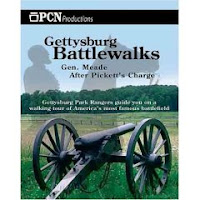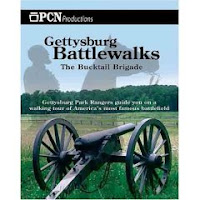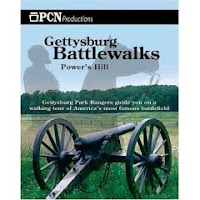
Gettysburg Battlewalks: General Meade After Pickett's Charge, Troy Harmon, Pennsylvania Cable Network, 1 hour 50 minutes, 2005, dvd. $20.
Did Meade want to fight at Gettysburg? Did Meade want to retreat on the evening of July 2nd? Why didn't Meade counter-assault the Army of Northern Virginia after the Pickett-Pettigrew-Trimble charge? Troy Harmon, National Park Service ranger addresses these questions. He states the answers quickly with "Yes. No. He tried".
Harmon quotes the memoirs and testimony, before the Committee on the Conduct of the War (CCW), of Sedgwick, Hancock, Sickles, Butterfield, Birney, Pleasanton and Warren. He also cites Longstreet's memoirs. Each of these men were Meade detractors. Hancock and Sickles were wounded and off the field and yet testified as if they had been there on the late afternoon of July 3rd. Longstreet was on the opposing side. Pleasanton Birney and Butterfield were on the battlefield and testified against Meade in Congressional hearings. Warren's testimony wavered between 'he did-he didn't'. As a trend within the testimony, Harmon sees the CCW hearings as a 'clear Meade out of the way for Grant' mentality.
Harmon covers the Meade's actions from 1p until 7p on July 3rd. The ranger's conclusion is that Meade did try to organize an immediate offensive and that it was a partial success.
Pleasanton, commander of the Army of the Potomac's cavalry, recalled a provocative remark that he made to Meade. "I'll give you an half an hour to show that your are a great general." Like many of Pleasanton's recollections, this one was written and published after the chief witness, in this case Meade, is dead. Understating the irony, Harmon describes Meade's actual order to Pleasanton and Pleasanton's inability, as commander, to achieve the slightest degree of success. Farnsworth's Charge and Merritt's Charge, on South Cavalry battlefield, yeilded only Federal casualities.
The Sixth Corps had marched 32 miles on July 2nd and was the offensive/defensive reserve of the Army of the Potomac. With Sedgwick's Sixth Corps scattered about the battlefield tending to the support of the 11th Corps on Cemetry Hill, Meade personally ordered the advance of the two brigades of the Fifth Corps' Pennsylvania Reserves Division. As one brigade, located between the Round Tops, challenged CSA sharpshooters in the Devils Den, two brigades advanced for a second time across Plum Run. At dusk on July 2nd, these two Pennsylvania Reserve brigades cleared the north slope of Little Round Top, Plum Run and the Wentz Farm.
Harmon reports that at approximately4:15p on July 3rd, Meade met with Sykes, Sedgwick, Warren, Pleasanton and Crawford on Little Round Top. He ordered Sykes to advance Crawford's Division, called an armed reconnaissance to clear the Wheatfield. He also ordered Pleasanton advance the cavalry in an armed reconnaissance on to the Warfield Ridge and to the Emmittsburg Road.
Longstreet’s Corps stretched from the Trostle Barn to Bushman Hill, from McLaws' division's left flank to Hood's divisions right flank. The gap, which Hancock cites in CCW testimony, is to the left of McLaws' division, where Pickett reported to Lee, "Sir, I have no division." Longstreet's corps had no cavalry flankers. All the available CSA cavalry was east of the Army of the Potomac and fought that morning to gain the Low Dutch Road which led to Powers' Hill, the ‘Grand Central Station’ of the Army of the Potomac. If Meade had been forced to retreat he would have sent the army south on the Baltimore Pike and the Taneytown Road.
CSA cavalry success on the Low Dutch Road would have imperiled any Federal movement on the Taneytown Road, explains Harmon.
Though Pleasanton's efforts are in vain, Crawford's Pennsylvania Reserves and Niven's brigade are successful in checking for strenghth, location and morale of the rebel force in front of the Federal left. On the right of the Federal advance, several of Niven's regiments make it to the Emmitsburg Road where they discover McLaws' division in wait immediately to the west. On the left of the Federal advance, Harmon explains that about half of the15th Georgia was gobbled up along with their colors by the 6th Pennsylvania Reserves as they rushed the Wheatfield and Houck’s Ridge. The ranger keenly notes that Houck's Ridge and the crest of the Wheatfield is actually elements of the same topographic feature.
In closing Harmon cites Edwin Coddington’s conclusions that:
1. the Sixth Corps was not fully available
2. from 4:15p to 4:45p Meade was on Little Round Top with his commanders
3. at approximately 4:45p Meade ordered Sedgwick to concentrate the Sixth Corps' troops
and make an armed reconnaissance immediately
4. by 5:30p 10,000 men available Munshower Knoll, immediately north of Little Round Top
Harmon and Coddington both understand that the window of attack is 4:00p-5:00p and that sunset is 7:15p, three hours after the end of PPT charge. From reports, Harmon as found that Longstreet pulled out and moved west of Warfield Ridge by 6p. Harmon cites Federal cavalry general Merritt report as stating that a rainstorm began at about 7p.
Like nearly all PCN Gettysburg tours, the viewer needs to have readily available maps such as McElfresh's watercolor map showing 1863 roads, fences and crops and the Desjardin/Friends of Gettysburg map of troop movements, along with a Trailhead Graphics map of contemporary roads and monument locations. The viewer who has read one or two full length treatments of the battle, such as Trudeau's or Sears, is well served by Harmon's tour. The order of battle in these books are handy while viewing the dvd. Novices may find this description of this portion of the battle and battlefield perplexing.







